 |
Lonaconing Iron Furnace
Main
Street
Lonaconing, Maryland |
|
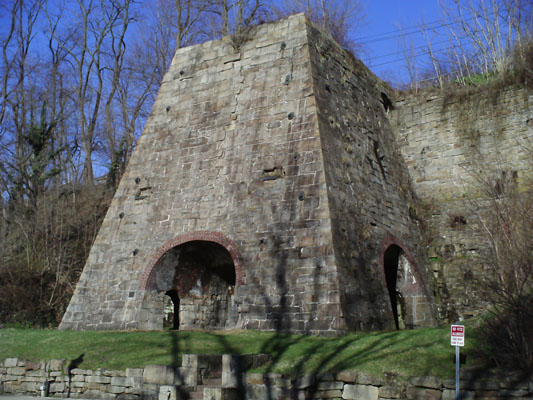 The George's Creek Coal and Iron Company, a corporation chartered by the State of Maryland in 1834, began building Furnace Number One, the first of four intended, iron-rendering blast furnaces to occupy the present site at the foot of Dug Hill, a spur of the Savage Mountain Ridge, a few hundred feet from what is now Main Street (State Route 36) in the middle of Lonaconing, Maryland.
The George's Creek Coal and Iron Company, a corporation chartered by the State of Maryland in 1834, began building Furnace Number One, the first of four intended, iron-rendering blast furnaces to occupy the present site at the foot of Dug Hill, a spur of the Savage Mountain Ridge, a few hundred feet from what is now Main Street (State Route 36) in the middle of Lonaconing, Maryland.
The furnace foundation was started approximately August 20, 1837; after wintering over, the foundations for the side walls were dug during February, 1838, and the winter cover of the furnace removed; all of the parts assemblies for the steam engines, which would power the air-blast compressors, were on site and ready to install. By September, the steam engines were installed, and the furnaces for the steam boilers finished. Just before Winter closing, by the end of September, the steam engines were tested and adjusted. In February, 1839 the furnaces to heat the blast-air stream were tested; in April, the furnace chamber was filled with coal, and the coal ignited to heat and set the masonry work inside the furnace chamber.
May 16th, 1839: the furnace was filled with iron ore, fragmented coal and coke, and additives, then lit. On May 17th, the iron outlet plug was removed and the first pour of liquid cast iron ran out of the furnace, through the distribution channels, and into the molds -- the first commercial run in the U.S. to use bituminous coal. Perhaps, the first run in the world to use the basic, coal-fired "pig-iron" production method still in use today (although other furnaces went into operation at roughly the same time -- no secret process could stay secret for very long at that time).
|
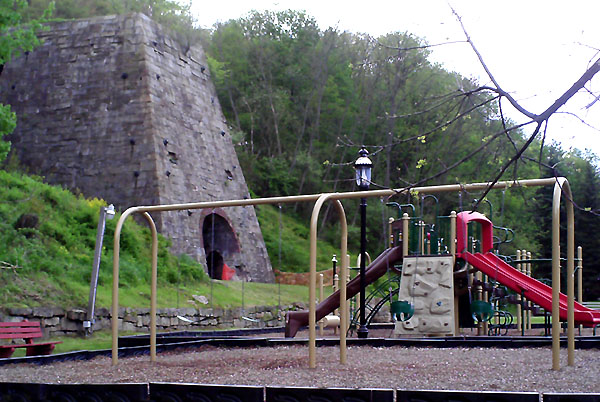 From the beginning, Furnace One was planned as an engineering prototype, an experimental batch-type blast furnace, which would use a bituminous-coal/coke mixture, rather than charcoal, as the furnance fuel. Use of the coal/coke mix, manufactured on-site, would result in a substantial manufacturing cost savings. In the money of the time, the four furnaces were expected to produce cast iron ingots (pig iron) at $15/ton with a wholesale price at the furnace loading dock of $25/ton.
From the beginning, Furnace One was planned as an engineering prototype, an experimental batch-type blast furnace, which would use a bituminous-coal/coke mixture, rather than charcoal, as the furnance fuel. Use of the coal/coke mix, manufactured on-site, would result in a substantial manufacturing cost savings. In the money of the time, the four furnaces were expected to produce cast iron ingots (pig iron) at $15/ton with a wholesale price at the furnace loading dock of $25/ton.
A batch typically required 12-24 hours, and Furnace One's average output was about 60 tons/week -- per day, a cube of iron 3.25 feet on each side -- although 75 tons/week was recorded. Reinforcement pins at the C&O canal were traced to this furnace and its adjoining casting house.
The intended other three furnaces were never built, but Furnace One was operated until 1855,
when the local markets were fully stocked with cast iron products, larger and more efficient furnaces had been constructed, and cheaper imported pig iron competed with local material in the water-front cities.
The furnace structure is approximately fifty foot square at the base, fifty feet high, and converges to a thirty foot square top; it was built into the hillside, using retaining walls, to permit ore and coal cars easy access, via an arched bridge, to the loading port at the top; the furnace combustion chamber height was recorded as 18 feet high and slightly over five foot at its widest. The brick cupola and the flagstone cap at the top of the furnace, and wood-constructed weighing house at the front of the bridge, are gone. To be best of local knowledge the fire-brick-walled furnace chamber, where the ore/coal mixture burned, is intact and protected from further weather by debris. The steam engines, compressor, and other valuable items were sold before the Civil War and the auxillary furnaces dismantled for their masonry value.
|
| An alcove in the front of the structure give access to the molten iron discharge port. The molds, (called pigs ) which caught the liquid iron flowing from the opened port, would have been on the floor of the chamber in front of the discharge port. The molten iron was at an estimated 3000 F. and flowed very easily.
Access tunnels through the structure to right and left allowed workers to move into the two side areas which housed the blast furnace machinery.
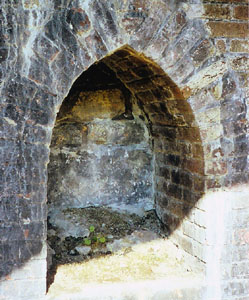 |
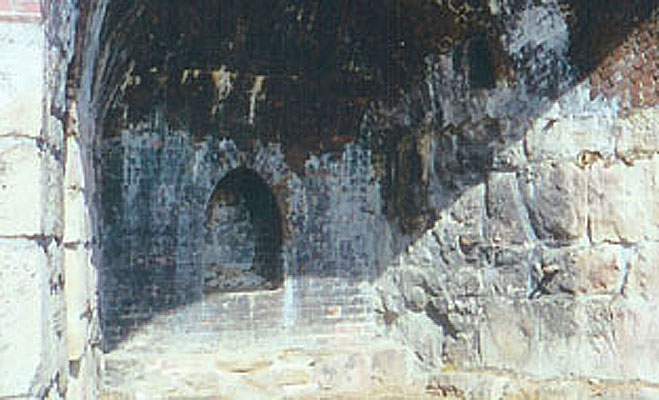 |
|
The two side courts, right and left of the support structure, and the associated terrace area held the blast furnace operational machinery -- air compressors to provide the air blast which forced and controlled the burning of the coke/iron-ore mixture; steam engines, totally 60 horse-power, which ran the air compressors; boilers which fed the steam engines; and furnaces which heated the blast-air stream. |
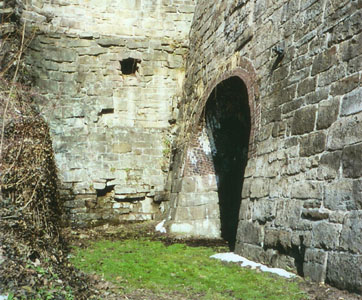 |
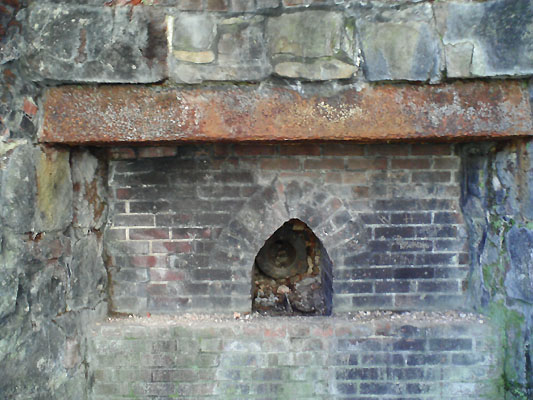 |
Interior of the right side access chamber, where the heated and compressed air stream was piped into the feed pipe (presently plugged with debris) which enters the main lower part of the furnce where optimum burning would occur. This air blast, which ran through cast iron piping into the furnace, is estimated to have been at 700 F and about 2-3 pounds per square inch pressure with a total flow of 3200 cubic feet / minute. A secondary furnace and boiler ran a steam engine which powered an air compressor to create the "blast" of the blast furnace - another secondary furnace heated the compressed air.
All of the brick was hand-made at the site, from clay deposits in the local area; small, stacked stone, coal-fired kilns were used to fire the bricks. The structural sandstone blocks were quarried mostly from the ridge above the furnace site. The lime for the mortar was made from local limestone deposits and burned to lime in similar ovens built at the site, much the same standard way charcoal and coal-derived coke were produced at that time.. |
| |
|
Some of the related artifacts still exist -- too large for the George's Creek history room exhibit, this car is to be seen on the Furnace Park grounds. Most likely, the wheels and other cast iron parts were cast in a shop in the local area with iron from this furnace.
In 1973, the Lonaconing Iron Furnace -- also known as the George's Creek Coal and Iron Company Furnace Number One -- was listed as Structure Number 73000886 on the National Register of Historical Places,
|
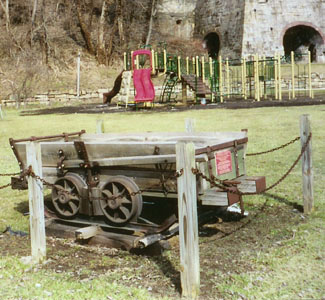 |
 |
Available to the right party:
One, 170 year old, coal fired, iron ore blast furnace -- complete with original owner's manual. (Needs some repair.) |
During the construction of the furnace, the various Superindentents of the George's Creek Iron and Coal Company kept extensive notes about the building operations. These notes still exist and are known as the Lonaconing Journals. These journals were edited and annoted by Katherine A. Harvey, and in March, 1977 were published by the American Philosophical Society, Independence Square, Philadelphia, Pennsylvania. A copy of this publication is available for viewing in the "History Room" at the George's Creek Regional Library, Main Street, Lonaconing, Maryland.
Like all historical structures, the Iron Furnace is showing its age again and needs refurbishing; further information is provided on the restoration page as it becomes available.
|
Questions? Comments! --
- - - - web8@midatlantic.cc
George's Creek History Exhibit
Post Office Box 240
Lonaconing, Maryland 21539 | |
Lonaconing Snapshots
A collection of pictures of the local area
surrounding the Iron Furnace park.
- - - - www.lonaconingtown.com
|
PUBLISHER'S NOTE: This information is published as a public service and is acquired from many sources -- accuracy cannot be guaranteed; please use all Internet-derived information with caution.
copyright 2023 - RK&A, Lonaconing, Maryland - rka@midatlantic.cc
|